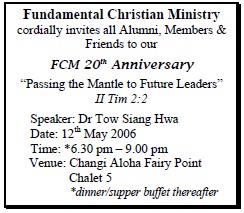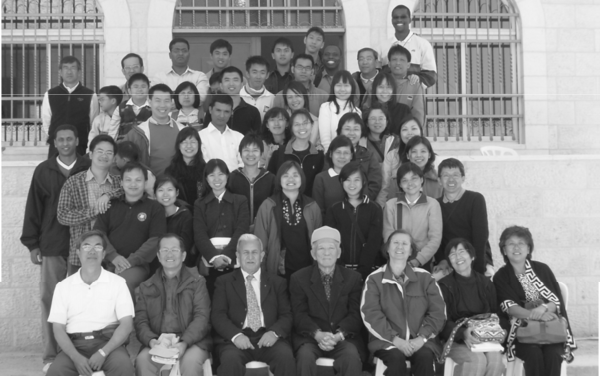PASTORAL CHAT
My dear Readers
Mrs Quek Siok Eng has reported very fully on our trip to the Holy Land except our visit to the Baraka B-P Church at Shepherd’s Field. It is a growing Palestinian Church whose first pastor, Rev George Awad has been a nurse in Jerusalem has resigned to be full-time pastor and his son, Rev Danny Awad graduated from Philippines with Filipino wife and two little girls has become the youth pastor.
I came at the right moment to ordain another who has just returned from study at the Westminster Theological Seminary, USA, and this young man wishes to be ordained a young deacon while he teaches at the Bethlehem Bible College which I happily did.
You can see here is a growing Palestinian Church which is the work of founding missionary doctor pastor, Dr Lambie whose work is left at Baraka Conference Centre which we stayed when we visited the Holy Land except this twelfth visit.
We are happy to report the growth of this young Palestinian Church and are assured of more good news to come from this Church in the near future.
Last Wednesday April 5, my brother Dr. S. H. Tow and I paid a visit to Elder Mahadevan at Ward 76 Room 4. Mrs Mahadevan and son and daughter-in-law, both doctors were also there. Elder Mahadevan has been warded there for a week or so under chemotherapy. We prayed for him to get well.
This Lord’s Day April 9, Judith and Deborah Mae will come to fetch Mrs Tow and me to Kelapa Sawit to speak at 10 am and they to sing thereafter. The occasion would be the 54th Anniversary since Kelapa Sawit’s founding and I was with them then. Now Mr Tee Chung Seng, a graduate of FEBC, is in charge of Kelapa Sawit. He has expanded to Jemaluang, 13 miles south of Mersing, and from Jemaluang will come seven or eight worshippers to rejoice with Kelapa Sawit.
On Friday April 14 we of True Life shall worship at RELC on Good Friday and take the Lord’s Supper. Easter Sunday morning we shall be at Labrador Park like last year 7 am. The Pastor shall preach a happy message from Romans 10:9, “That if thou shalt confess with thy mouth the Lord Jesus, and shalt believe in thine heart that God hath raised him from the dead, thou shalt be saved.” There will be many who will kneel together to receive Christ as Saviour and there will be dining together. For He is risen from the dead and we are saved.
Your affectionate pastor
T. T.
***************
THE GOSPEL OF LIFE: Chapter XIX
John 19:25-27
“Having loved His own . . . He loved them unto the end.” (John 13:1)
“Love is as strong as death” (Song of Solomon). Thus when the Ten disciples were fled from the Master, John the Eleventh, the disciple whom Jesus loved and who loved Jesus, and the women who also loved Jesus, kept vigil by the cross.
The women who loved Jesus were naturally His mother, his mother’s sister, Mary wife of Cleophas and Mary Magdalene. Of the last three, the best known is Mary Magdalene, out of whom Jesus had cast out seven demons. She who is forgiven much loveth much. Surely the loving sympathy shown by Jesus’ beloved disciple and by the women had encouraged our Saviour to persevere on the cross. “Were you there when they nailed Him to the tree . . . Sometimes it causes me to tremble, tremble, tremble . . .”
The loving kindness of Mary to the Lord, her Son, to the last evoked a reciprocal filial piety. Having also His beloved disciple by His side, He honoured John by entrusting His mother to his care. Suppose Mary and John had not come? How many a blessing have we missed by not coming to Church, to the Lord’s Table, to the Prayer Meeting, to a Church Camp or Conference, where our Lord is there to bless. “For where two or three are gathered together in my name, there am I in the midst of them” (Matthew 18:20). But unless our attendance is spontaneous, motivated by the same love that drew John and the women to the foot of the cross, our service for the Lord would not avail.
A Chinese servant told her story how she had served her European towkay at his seaside mansion in the last days of his lonesome life. Yet, when he died, all she got from him was a T.V. set. A question arose in my mind: If she had served him as earnestly the many years before this, might she not have been rewarded with the house? How we attend to our Lord is important.
Christ is the best Master to work for. For He loves His servants and promotes them to be His friends, yea, His very own. “Having loved His own He loved them to the end”.
John 19:25-42
“. . . was crucified, dead and buried.” — Apostles’ Creed
This statement from the Apostles’ Creed is based on St Paul’s definition of the Gospel in I Cor. 15:1-4 “. . . that Christ died for our sins according to the Scriptures, and that He was buried . . .”
As for the Apostle John he describes as an eye-witness the physical suffering of our Lord, how as His blood ran thin, He thirsted. And how when He was relieved by vinegar, He gathered strength to utter the Victory cry, “It is finished”, before He bowed His last.
As death in an execution must be medically certified in modern judicature, the same was required under Roman law. In our Lord’s case, His death was trebly attested by John, as blood and water flowed from His pierced, riven side. This led to the fulfilment of a double Messianic prophecy.
Whether Jesus died of a broken heart literally is a matter of argument. The fact recorded in Scripture is that He died. He died as a result of fully suffering the pains of death on the cross for our sins. This fact is important because if He did not die, our penalty was not fully paid. Our salvation would not be complete.
The fact that He died repels such heretical attacks by enemies of the Gospel: 1) An ancient heresy of the second century called Docetism held that Christ had no real body or human soul. His earthly manifestation in human form was a phantasm, a mere appearance without substance or reality. Hence those heretics were called Docetists, from the Greek verb which means “to appear”. According to the Docetists, Christ’s whole earthly life was an illusion. This denial of the human nature of Christ is condemned by John in 1 John 4:1-3.
2) The death of Christ refutes a modernist lie called the swoon theory. This theory suggests Christ did not really die, but swooned. There in the coolness of the tomb He revived! (New Bible Dictionary) But the evidence from the beloved disciple is that Christ did die, for blood and water had flowed from His riven side. A dead person had swooned a hundred times over!
The burial of Jesus is again fully attested, the well-known people involved are mentioned by name, the beauty spot identified, and the hour recorded. For unless Christ had died and was buried, how could there be a resurrection? Hence the account of His crucifixion, death and burial is repeated in the Apostles’ Creed for our salvation.
“Were you there when they laid Him in the tomb? . . . Sometimes it causes me to tremble, tremble, tremble . . .”
Chapter XX
“. . . the third day He arose again from the dead.” — Apostles’ Creed.
The eye-witness to our Lord’s crucifixion, death and burial has plenty more to tell of His Resurrection! The miracle of His resurrection is one of “many signs that truly Jesus did in the presence of his disciples” and is written “that ye might believe that Jesus is the Christ, the Son of God; and that believing ye might have life through his name” (Jn. 20:31).
John gives us a more detailed account of the first Appearance that Easter Sunday morning than the other Evangelists because he was one of the two groups of disciples who went to the Empty Tomb.
It is he who retells Mary Magdalene’s eyewitness story. Although the other women who were with Mary Magdalene at the cross also went, these are not mentioned particularly in John except in the “we” of Jn. 20:2. It tells also of John’s race with Peter to the Tomb and how although he outran the older man, it was Peter who went into the sepulchre to examine the “scene”.
John elaborates further on Luke’s account of the Appearance to the Ten. Thomas in absentia, and John alone completes with the Appearance to the Eleven on the following Lord’s Day, Thomas now present. According to Jewish way of inclusive calculation, like the Chinese, after eight days means after seven days in the English way of calculation.
“Peace be unto you”, (Shalom) the usual custom of Hebrew salutation takes on a brighter meaning when used by the Risen Saviour for His brethren (Jn. 20:17). And when it is used a second time (Jn. 20:26), its usage should be confirmed upon the whole Christian Church! “Peace be unto you” was the new salutation taught by early missionaries to China to their converts. It has since gained currency in greetings between Christians in speech and letter correspondence. In countries that have experienced little peace, especially China which is in constant turmoil of revolutions, “Peace be unto you” when uttered in salutations has brought comfort and hope and cheer from Him who has conquered death and risen victorious from the grave. Peace be to you, my Reader, whatever your trouble! Upon this Lord’s Day, be sure to meet the Risen Saviour with your brethren in Church!


Pilgrims at Baraka Bible-Presbyterian Church (Shepherd’s Field), Bethlehem
FEBC-True Life 12th Holy Land Pilgrimage, March 9–23, 2006


